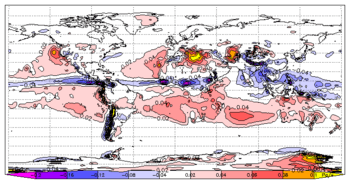Tropical climate

A tropical climate in the Köppen climate classification is a non-arid climate in which all twelve months have mean temperatures of at least 18 °C (64 °F). In tropical climates there are often only two seasons: a wet season and a dry season. Tropical climates are frost-free, and changes in the solar angle are small. In tropical climates temperature remains relatively constant (hot) throughout the year.
Sub types
Within the tropical climate zone there are distinct varieties based on precipitation:
Tropical rainforest climate
All 12 months have average precipitation of at least 60 mm (2.4 in). These climates usually occur within 10° latitude of the equator. This climate is dominated by the doldrums low-pressure system all year round, so has no natural seasons in terms of thermal and moisture changes.
Cities featuring a Tropical rainforest climate
|
|
Some of the places with this climate are indeed uniformly and monotonously wet throughout the year (e.g., the northwest Pacific coast of South and Central America, from Ecuador to Costa Rica; see, for instance, Andagoya, Colombia), but in many cases, the period of higher sun and longer days is distinctly wettest (as at Palembang, Indonesia) or the time of lower sun and shorter days may have more rain (as at Sitiawan, Malaysia).
(Note. The term aseasonal refers to the lack in the tropical zone of large differences in daylight hours and mean monthly (or daily) temperature throughout the year. Annual cyclic changes occur in the tropics, but not as predictably as those in the temperate zone, albeit unrelated to temperature, but to water availability whether as rain, mist, soil, or ground water. Plant response (e. g., phenology), animal (feeding, migration, reproduction, etc.), and human activities (plant sowing, harvesting, hunting, fishing, etc.) are tuned to this 'seasonality'. Indeed, in tropical South America and Central America, the 'rainy season' (and the 'high water season') is called invierno or inverno, though it could occur in the Northern Hemisphere summer; likewise, the 'dry season' (and 'low water season') is called verano or verão, and can occur in the Northern Hemisphere winter).
Tropical monsoon climate
This type of climate results from the monsoon winds which change direction according to the seasons. This climate has a driest month (which nearly always occurs at or soon after the "winter" solstice for that side of the equator) with rainfall less than 60 mm, but more than 1/25 the total annual precipitation.[1]:200–1:208
Cities featuring a Tropical monsoon climate
|
|
Tropical wet and dry or savanna climate
Aw climates have a pronounced dry season, with the driest month having precipitation less than 60 mm and less than 1/25 of the total annual precipitation.[1]:208–11
Cities featuring a Tropical savanna climate
Most places that have this climate are found at the outer margins of the tropical zone from the low teens to the mid-20s latitudes, but occasionally an inner-tropical location (e.g., San Marcos, Antioquia, Colombia) also qualifies. Actually, the Caribbean coast, eastward from the Gulf of Urabá on the Colombia–Panamá border to the Orinoco River delta, on the Atlantic Ocean (about 4,000 km), have long dry periods (the extreme is the BSh climate (see below), characterised by very low, unreliable precipitation, present, for instance, in extensive areas in the Guajira, and Coro, western Venezuela, the northernmost peninsulas in South America, which receive <300 mm total annual precipitation, practically all in two or three months).
This condition extends to the Lesser Antilles and Greater Antilles forming the circum-Caribbean dry belt. The length and severity of the dry season diminishes inland (southward); at the latitude of the Amazon River—which flows eastward, just south of the equatorial line—the climate is Af. East from the Andes, between the dry, arid Caribbean and the ever-wet Amazon are the Orinoco River's llanos or savannas, from where this climate takes its name.
Sometimes As is used in place of Aw if the dry season occurs during the time of higher sun and longer days. This is the case in parts of Hawaii, northwestern Dominican Republic, East Africa, and the Brazilian Northeastern Coast. In most places that have tropical wet and dry climates, however, the dry season occurs during the time of lower sun and shorter days because of rain shadow effects during the 'high-sun' part of the year.
Examples
- Monte Cristi, Dominican Republic (As)
- Recife, Brazil (As)
- Natal, Brazil (As)
- Trincomalee, Sri Lanka (As)
- Mombasa, Kenya (As)
Exceptions
Owing to different causes certain places within the tropics do not have a tropical climate, such as some desert areas and alpine regions.
- Examples:
- Southern part of Arabian Peninsula.
- The Sahara Desert.
- Alpine regions of the tropics. Mountaintops within the tropics, e.g. Mount Kenya, can be cold. However, like lowlands in the tropics (and unlike cold winter temperate zone regions), there is little seasonal variation of temperature.
Intertropical Convergence Zone

Because of the effect of sun angle on climate most areas within the tropics are hot year-round, with diurnal variations in temperature exceeding seasonal variations. Seasonal variations in tropical climate are dominated by changes in precipitation, which are in turn largely influenced by the tropical rain belt or Intertropical Convergence Zone (ITCZ), a portion of the Hadley cell. The ITCZ is shown, for July average, in the graphic. Areas of ascending air have heavy rainfall; areas of descending air are dry. The ITCZ somewhat follows the solar equator throughout the year, but with geographical variations, and in some areas (India) is heavily influenced by local large-scale monsoons.
See also
References
| Wikimedia Commons has media related to Tropical climate. |